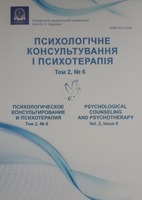Preliminary results of several small sample studies in the Ukraine, during TRE trainings on different levels
Abstract
Tension, Stress und Trauma Releasing Exercises (TRE) are a sequence of seven exercises used to trigger neurogenic tremor. The aim of this tremor is to reduce symptoms of post-traumatic stress disorder PTSD and other stress-induced symptoms. This article describes the investigation оf the effects of TRE by a standardized questionnaire which offered also space for quantitative comments. We can demonstrate that TRE do not only relief heаlth complaints directly after the trainings, but has also a positive long term effect after some month.
Downloads
References
Ahn, H. & Wampold, B.E. (2001), Wher oh where are the specific Ingredients? A Meta-Analysis of Component Studies in Counseling and Psychotherapy. Journal of Counseling Psychology 48 (3), 251-257.
Benedetti, F. ((2002), How the Doctor`s Words Affect the Patients Brain. Evaluation & the Health Professionals, 25 (4), 369-386.
Berceli, D. (2010), The Revolutionary Trauma Release Process, Vancouver: Namaste.
Berceli, D. (2010a), The Effects of Neurogenic Tremors on the Human Body, Manuscript.
Berceli, D. (2010b), Neurogenes Zittern. Eine Körperorientierte Behandlungsmethode für Traumata in grossen Bevölkerungsgruppen, in: Trauma & Gewalt, 4. Jahrgang, Heft 2/2010, S. 149ff.
Berceli, D. (2012), Körperübungen für die Traumaheilung, Papenburg: Niba-ev.
Berceli, D. (2014), Powerpoint Modul I.
Berceli, D. (Hrsg.) (2015) Shake it off Naturally, o.O.: Create Space Independent Publishing Platform.
Berceli, D. (o.J.) DVD The Revolutionary Trauma Release Exercises, Namaste Publishing.
Bohne, M. (2014), Reden reicht nicht. Eröffnungsvortrag auf der Tagung "Reden reicht nicht", Heidelberg, 2.-5. Mai 2014.
Bohus, M. (2014), Wie profitiert die therapeutische Praxis von der neubiologischen Forschung. Das Rätsel der Dissoziation. Vortrag auf der Tagung "Reden reicht nicht", Heidelberg, 2.-5. Mai 2014.
Butollo, W., Hagl M, Krüsmann M (1998), Leben nach dem Trauma, München: Pfeiffer.
Butollo, W., Karl R (2012), Dialogische Traumatherapie, Stuttgart: Klett-Cotta.
Emerson, D, Hopper, E (2012), Trauma-Yoga, Heilung durch sorgsame Körperarbeit, Lichtenau/Westfalen: Probst.
Eschenröder, C. (2014, Wie wirksam sind Techniken der Energetischen Psychotherapie, die Exposition mit sensorischer Stimulierung verbindet? Psychotherapeutenjournal 2, 149-155.
Follete, V.M., et al. (2015), Mindfullness-Oriented Interventions for Trauma, New York, London: Guilford.
Geller, S. & Porges, S. (2014). Therapeutic Presence: Neurophysiological Mechanisms Mediating Feeling Safe in Therapeutic Relationships. Journal of Psychotherapy Integration, Vol. 24, No. 3, 178–192
Grand, D. (2014), Brainspotting, Kirchzarten: VAK.
Grunwald, M. (2014). Neurobiologische Funktionen von Selbst- und Fremdberührungen. Vortrag auf dem internationalen Kongress "Reden reicht nicht", Heidelberg, 2.-5. Mai 2014.
Horowitz MJ (2013), Stress Response Syndromes, PTSD, Grief, Adjustment and Dissociative Disorders, Lanham Maryland: Jason Aronson.
Krummenacher, P. & Gaab, J. (2013) Klinische Nutzung der Placeboreaktion. PSYCHup2date 7, 199-201.
Levine, P. (1998), Trauma-Heilung, Essen: Synthesis.
Levine, P. (2010), Sprache ohne Worte, München: Kösel.
Levine, P. (o.J.), Manuel Somatic Experiencing Training, Das erste Jahr, B1.4.
Neue Zürcher Zeitung 16. September 2016, Kiews harter Weg über den Berg, p. 29
Ogden, P. Minton K, Pain C (2010), Trauma und Körper, Paderborn: Junfermann.
Porges, S. (2011). The polyvagal theory. Norton & Company, 2011
Reddemann, L (2004), Psychodynamisch Imaginative Traumatherapie PITT – Das Manual, Stuttgart: Klett-Cotta.
Rothschild, B. (2000), The Body Remembers, New York: Northon.
Rüegg, J,K. ( 2011), Gehirn, Psyche und Körper, Stuttgart: Schattauer.
Sack, M. (2010), Schonende Traumatherapie, Stuttgart: Schattauer.
Scaer, R. (2007), The Body Bears the Burden, New York, London: Routledge.
Scaer, R. (2014), Das Trauma-Spektrum, Lichtenau/Westfalen: Probst.
Seidler, K. (2006), Geburt, Tod und Wiedergeburt des Dodo-Vogels: Mythen der Psychotherapie und Psychotherapieforschung. Psychotherapieforum14, 146-152.
Shapiro, F. (1998), EMDR, Grundlagen und Praxis, Paderborn: Junfermann.
Spangenberg, E. (2015), Behutsame Trauma-Integration (TRIMB), Stuttgart: Klett-Cotta.
Spitale, I. et al. (2008), Wirksamkeitsvergleich zwischen Hypnotherapie und Körperpsychotherapie. Eine Studie zur Praxisevaluation. Download MEI Tübingen, abgerufen am 28.7.2016 http://www.meg-tuebingen.de/downloads/2008-04%20Hypnotherapie%20und%20Koerperherapie%20Zus.pdf
Tschuschke, V. (2014), Zur aktuellen Lage der Psychotherapieforschung und ihrer Auswirkungen - Irrwege und Auswege. Vortrag auf dem internationalen Kongress "Reden reicht nicht", Heidelberg, 2.-5. Mai 2014.








